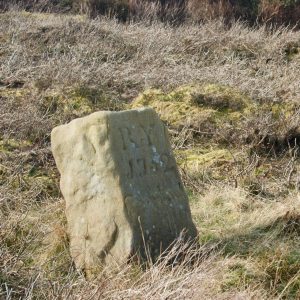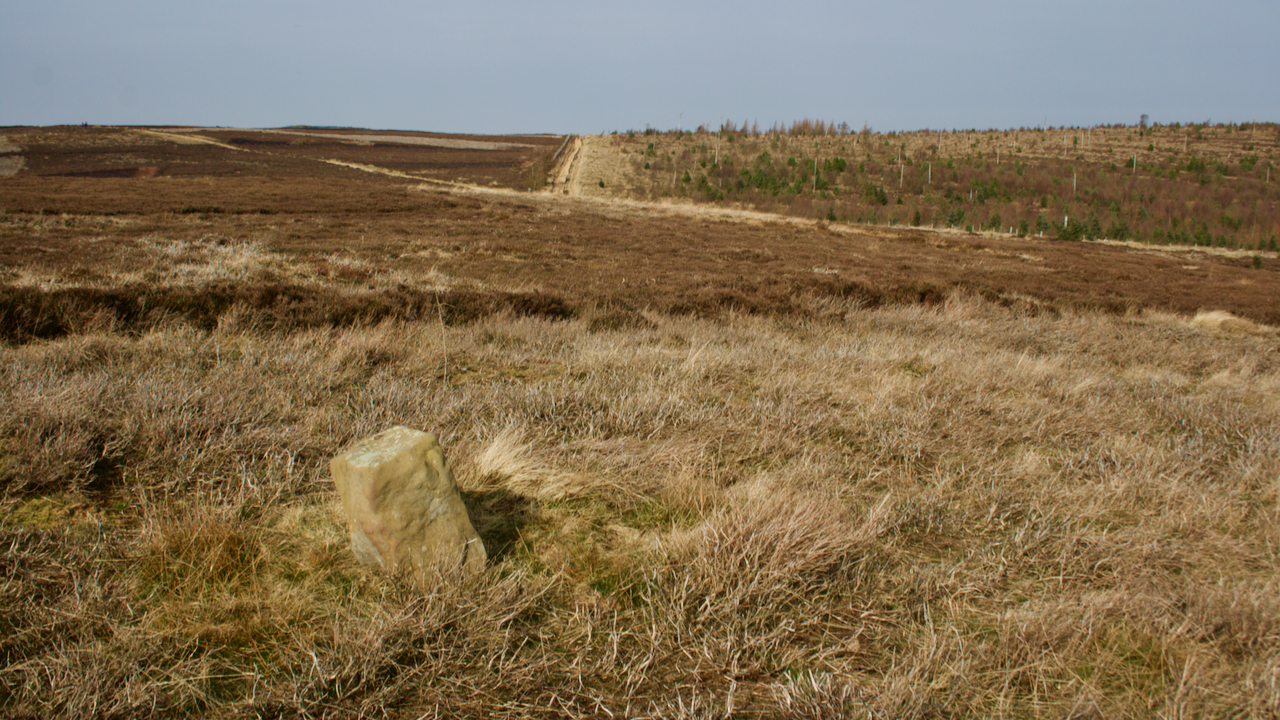
I am slowly getting around every boundary stone on these northern moors.
This one is inscribed “RY 1752”, identical to the stone 600m or so to the south west. Ralph Yoward must have had a bulk buy.
1752 — George II was on the throne; the 11 days between 3rd and 13th September inclusive were ‘skipped’ as the Gregorian calendar was adopted1Wikipedia Contributors (2022). 1752 in Great Britain. [online] Wikipedia. Available at: https://en.wikipedia.org/wiki/1752_in_Great_Britain#Events [Accessed 22 Mar. 2022].; and James Cook was promoted to mate aboard the collier brig ‘Friendship’2Wikipedia Contributors (2022). James Cook. [online] Wikipedia. Available at: https://en.wikipedia.org/wiki/James_Cook#Early_life_and_family [Accessed 22 Mar. 2022]..
Now that is interesting.
But first, Ralph Yoward — I’ve posted about him twice before, here and here — so I won’t repeat. But to suffice, the Yoward family were lessees for that part of Hutton Manor which was retained by the Crown after the dissolution of Gisborough Priory in 1540.
A lease of this sort was generally held was for three generations, so after the death of his uncle Richard, Ralph had to renew the lease. This was done by the issue of Letters Patent at a cost of £800, an annual rent of £36 6s 8d and the condition that Ralph had to make a terrier or record of his land within a year and every seven years thereafter3Dixon, Grace. “Two Ancient Townships – Studies of Pinchinthorpe and Hutton Lowcross”. 1991. ISBN 0 9507827 2 6..
Nowadays we would use modern mapping and GPS but Ralph had to perambulate the perimeter of his land marking each significant point. Hence the stones. Practically he probably rode on a horse with his men dragging the stones on some form of cart or sled.
Right, back to the good ship ‘Friendship’ upon which James Cook was now a mate. By 1755, he had been offered full command but within a month he had volunteered for service in the Royal Navy.
We’ll leave Cook there to pursue his illustrious career which is well documented.
It is his old ship ‘Friendship’ which is more interesting.
It was a sturdy and flat bottomed ship, which plied the trade up and down the perilous East coast carrying coal from the Tyne to London. Cook was mate under a Captain Walker4Stamp, Tom and Cordelia. “James Cook Maritime Scientist”. 1976. Caemon of Whitby Press..
In the mid-18th-century, Stockton was a prosperous town with shipbuilding, brick, sail, and rope making industries. The Town House had been built in 1735, and the first theatre would open in 17665Wikipedia Contributors (2022). Stockton-on-Tees. [online] Wikipedia. Available at: https://en.wikipedia.org/wiki/Stockton-on-Tees#Early [Accessed 22 Mar. 2022]..
Access to the sea was long and winding, with several meanders of the tidal River Tees and shifting sandbars to navigate. It would not be until 1810 that first cut was made to straighten the river, the Mandale Cut6Wikipedia Contributors (2022). Tees Navigation Company. [online] Wikipedia. Available at: https://en.wikipedia.org/wiki/Tees_Navigation_Company#The_Mandale_Cut [Accessed 22 Mar. 2022]..
Perhaps the owners of the ‘Friendship’ were envious of the huge profits being made by ports on the west of the country such as Bristol, Liverpool and Whitehaven on the Atlantic slave trade. Perhaps they had higher ambitions than carrying coal from Newcastle. But we come across the ‘Friendship’ again in 1762 setting sail from Stockton for Saint-Louis in Senegal under a Captain George Haddon.
The Trans-Atlantic Slave Trade database7Slavevoyages.org. (2022). Trans-Atlantic Slave Trade – Database. [online] Available at: https://www.slavevoyages.org/voyage/database#results [Accessed 22 Mar. 2022]. lists this voyage as the only one leaving Stockton but there are 85 entries for ships by the name of ‘Friendship‘ in the period between 1652 and 1807. Obviously a popular name. The Stockton ‘Friendship‘ is described as 90 tons with a “Standardized tonnage” of 164.3. I found no other ship of this specification.
There is no record of Captain Haddon on any other voyage.
So it may well be that this ‘Friendship‘ is a completely different ship to Cook’s ‘Friendship‘ but surely deserves further research.
At Saint-Louis, 169 enslaved Africans were embarked bound for Patuxent in Maryland. 150 disembarked, 19 died on the Middle Passage.
The ‘Friendship‘ arrived back in London in 1764.
Addendum:
I’ve subsequently found that another ship ‘Friendship‘ was built at Whitby in 1783. This one was bigger at 155 tons and registered at London 8JONES, STEPHANIE KAREN. “A MARITIME HISTORY OF THE PORT OF WHITBY, 1700-1914”. Page 57. Thesis submitted for the Degree of Doctor of Philosophy in the University of London. 1982. UNIVERSITY COLLEGE LONDON. Lost in 1790 9Ibid. p96, so this could be either of those recorded in the Port Books for that year: for one entry Joseph Patton is the Master 10Ibid. p223, and for 4 voyages, the Master is Thos. Duncan.
So obviously neither is Cook’s ‘Friendship’ nor the slave trader but it does illustrate the frequency of the name and.
- 1Wikipedia Contributors (2022). 1752 in Great Britain. [online] Wikipedia. Available at: https://en.wikipedia.org/wiki/1752_in_Great_Britain#Events [Accessed 22 Mar. 2022].
- 2Wikipedia Contributors (2022). James Cook. [online] Wikipedia. Available at: https://en.wikipedia.org/wiki/James_Cook#Early_life_and_family [Accessed 22 Mar. 2022].
- 3Dixon, Grace. “Two Ancient Townships – Studies of Pinchinthorpe and Hutton Lowcross”. 1991. ISBN 0 9507827 2 6.
- 4Stamp, Tom and Cordelia. “James Cook Maritime Scientist”. 1976. Caemon of Whitby Press.
- 5Wikipedia Contributors (2022). Stockton-on-Tees. [online] Wikipedia. Available at: https://en.wikipedia.org/wiki/Stockton-on-Tees#Early [Accessed 22 Mar. 2022].
- 6Wikipedia Contributors (2022). Tees Navigation Company. [online] Wikipedia. Available at: https://en.wikipedia.org/wiki/Tees_Navigation_Company#The_Mandale_Cut [Accessed 22 Mar. 2022].
- 7Slavevoyages.org. (2022). Trans-Atlantic Slave Trade – Database. [online] Available at: https://www.slavevoyages.org/voyage/database#results [Accessed 22 Mar. 2022].
- 8JONES, STEPHANIE KAREN. “A MARITIME HISTORY OF THE PORT OF WHITBY, 1700-1914”. Page 57. Thesis submitted for the Degree of Doctor of Philosophy in the University of London. 1982. UNIVERSITY COLLEGE LONDON
- 9Ibid. p96
- 10Ibid. p223

Leave a Reply